10 Training Theories

Getting a clear grasp of different training theories will allow you to build more meaningful content and more effective learning and development programs for your employees. Here, you’ll find a quick rundown of theories of learning, emphasizing their key concepts and how you can apply them to achieve your training objectives. Read on to learn more.
1. Goal-setting theory
This training theory designed by Edwin Locke suggests that goal setting directly affects performance. From his decade’s worth of laboratory drives and field study experiences, he also found out that 90% of employees tend to put in more time and passion for learning if specific and more challenging goals drive them. This is because they feel a higher sense of accomplishment and self-satisfaction if they work harder to achieve these goals, than those that are generally easy and ambiguous.

How to apply this training theory:
There are several ways to apply this training theory to your training program. First and foremost, set and accomplish goals using the SMART model—Specific, Measurable, Aggressive, Realistic and Time-bound goals. Consider adopting this model to give your team a sense of direction and push them to perform better and achieve higher learning results. From there, break them down into smaller goals so that they don’t sound overwhelming and highly complex. You can also perform a regular performance review to track their progress towards the greater goal. Make sure to also include change management training courses as part of your training program. This will help your team successfully manage changes to the business.
Lastly, you need to make sure that all these goals are fully understood by your employees. Before implementing your training program, you can schedule a meeting with your team and go over the goals you’ve set for them and the knowledge and skills you want them to gain. You can also take into consideration their thoughts and insights to secure their commitment to your training initiative.
Sign up for Free and Start Using The Best LMS Platform
2. Behavioral learning theory
Behavioral learning is a training theory centered around the idea that people learn through their interactions with their environment. Basically, it assumes that learners react and behave based on the associations between stimuli and responses. Positive reinforcement plays a vital role in this training theory. For example, if your learners are rewarded every time they top their course assessments, then they will most likely study and work harder for their future training courses. By setting up an environment that rewards and recognizes excellent learning outcomes, they will form positive associations with your training and will most likely continue to exhibit the right behavior expected from them.
Behaviorism is often associated with cognitive theory, which states that people think and make decisions based on internal and external factors. In a way, it also relates to classical-conditioning, a learning type that associates two factors called neutral and unconditioned stimulus, leading to conditioned thinking.

How to apply this training theory:
Award-winning learning technology EdApp offers several reward solutions that can help positively influence your learners’ developmental behavior and push them to exert more effort into their learning. For starters, they offer microaggressions training courses that offer positive reinforcement techniques in order to create the desired behaviors in learners.
Additionally, they have an inbuilt star-based reward system in which learners can earn stars for undertaking the desired behavior (e.g. training completion according to deadline, frequency of app use, high scores for gamified assessments, etc). Users can then use the allocated stars to redeem real rewards, which will be decided based on your budget.
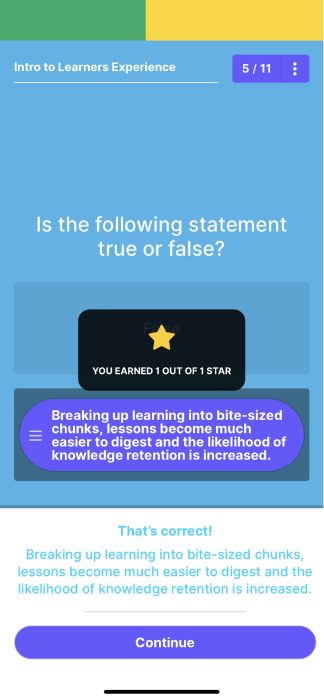
You can also take advantage of their Achievements feature to celebrate their learning progress in a unique and personalized way. Here, you can tailor banners and badges, and then reward them to those who have gone above and beyond the intended learning outcomes. All you need to do is set new behavioral goals and rules to earn each achievement, customize the messaging and branding, and deploy them to your deserving employees. To get started today, click through for a step-by-step guide to setting up your first Achievement.
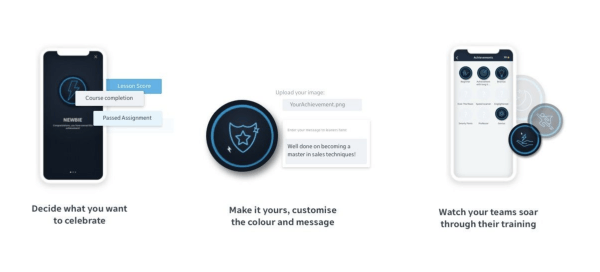
3. Adult learning theory
The principles of adult learning theory emphasize that adult learners have different qualities and needs than younger learners. It is primarily because adults carry a whole world of experiences behind them, meaning, they already have rich reserves of knowledge. Their willingness to learn is mostly driven by a goal, like gaining a new skill for career advancement or improving their weaknesses. They are also more mature, task-oriented, and prefer to learn at their own pace rather than being directed by an instructor.

How to apply this training theory:
The best way to apply this training theory to your training program is to involve your employees directly in the planning and development stages. Conduct an assessment, survey, or interview to determine the type of training and course topics they need, as well as the training method they prefer the most. And rather than presenting new knowledge through modules or PowerPoint presentations, consider involving some hands-on activities to further engage them.
4. Microlearning theory
The microlearning theory explains that learners absorb new information better if it is presented in short, concise bursts. In fact, a study found that lessons prepared in bite-sized formats can help improve focus and lead to long-term retention among learners by up to 80%, as opposed to subject-heavy teaching methods. Since the lessons are only focused on key elements or messages of a subject, learners can store the information easily in their long-term memory.

How to apply this training theory:
Building a training program based on this training theory doesn’t have to be expensive and time-consuming. All you need is the help of a dedicated microlearning authoring tool that can simplify the entire instructional course creation process—like EdApp. This blended-learning tool requires no coding or graphic design expertise. Simply choose from their 80+ beautiful elearning templates, copy and paste your content, and hit publish. If you don’t have the time or resources to create a training course from scratch, this platform also offers hundreds of ready-made microlearning courses that you can deploy for free. They tap into wide range training topics perfect for different industries, like retail employee training courses, business training courses, hotel management course, healthcare training courses, microaggressions training courses and more.
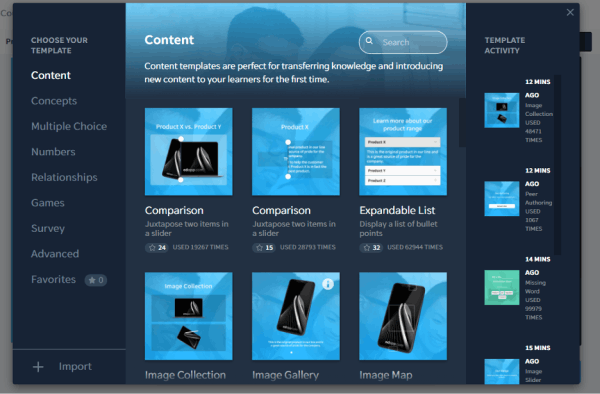
5. Constructivist Learning Theory
According to constructivist learning theory, people are more active learners than passive. Meaning, they learn best when they experience or discover things on their own, rather than simply being lectured. The idea of constructivism also argues that learning is a collaborative learning process and individuals are much more willing to take in new information or revise their existing knowledge from a meaningful and relevant interaction from another learner.

How to apply this training theory:
Most of the time, constructivist learning takes the approach of mentoring. While it’s common to appoint department managers and supervisors as mentors, seniors and excelling employees can also play the role. You can appoint them to your new hires, underperforming employees, or even those who are seeking to improve further their existing skills. For this method, learners will get the opportunity to follow someone with higher expertise but still function themselves, and then self-reflect from those experiences.
You can also initiate team-building activities, allowing learners to come together and actively participate in their learning. Peer training is another great way to utilize this training theory. Here, employees can share their own knowledge and absorb new ones from those who are more skilled and experienced in the field.
6. Learning Curve Theory
The learning curve is a term that is often used to describe how the learning process always begins difficult but gradually becomes easier. It points to the idea that an employee learns a skill faster and more efficiently by repeating the same task over and over again. This training theory was derived from the experimental study of Hermann Ebbinghaus, known as the Ebbinghaus Forgetting Curve. According to him, people tend to remember information more and store it in their long-term memory if the learning is rehearsed and repeated at predetermined intervals.

How to apply this training theory:
This training theory is traditionally applied to learning through the use of flashcards. But if you want to provide your employees with a more sophisticated learning method than this grade-school technique, EdApp can lend you a helping hand with its Brain Boost feature. This advanced tool significantly uses the powerful SM-2 algorithm, which automatically sends different questions to learners until the information is locked into their long-term memory. The more they get right, the less frequently they’ll need to be tested.
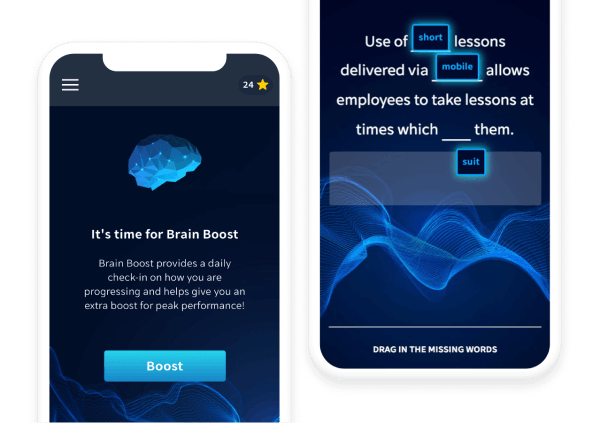
7. Gamification learning theory
The gamification learning theory states that use of game-like elements can help increase learner engagement and combat the boredom associated with formal training. By transforming learning into something more fun and stimulating, there’s a higher likelihood of engagement and participation from your learners. This is primarily because they see your training as a fun activity rather than another mandatory work task they must complete.
The gamification learning process utilizes usual smartphone games like drag-and-drop, sequencing, and matching to teach specific skills and concepts. It also involves leaderboards, points, achievement badges, levels, and progress bars to foster healthy competition among the learners.

How to apply this training theory:
Thankfully, there are now several LMS platforms that can help you gamify your training courses and learning materials even without any technical know-how. Currently, the best one on the market is EdApp LMS. This platform offers 50+ free game templates like multiple-choice, memory game, jeopardy game, next in order, and more. It’s so easy to use that all you need to do is populate them with your knowledge, questions, and answers, and it’s all good to go.

You can also design, edit, and schedule gamified courses using gamification training software like Qstream, Tovuti LMS, Gametize, and Edgagement. They are also applauded by most corporations due to their ease of use, although they aren’t exactly free to use and require at least a monthly subscription to maximize their tools and features.
8. Sensory Theory
Laird’s sensory theory suggests that learners are more receptive to learning if their multi-senses are stimulated. Derived from his experiential-learning, he found that 75% of adults learn and understand things better by seeing, 13% by hearing, and 12% by touching, smelling, and tasting. Basically, this training theory encourages trainers and managers to facilitate training and activities that will require learners to use as many senses as possible in order for them to easily remember and recall information.
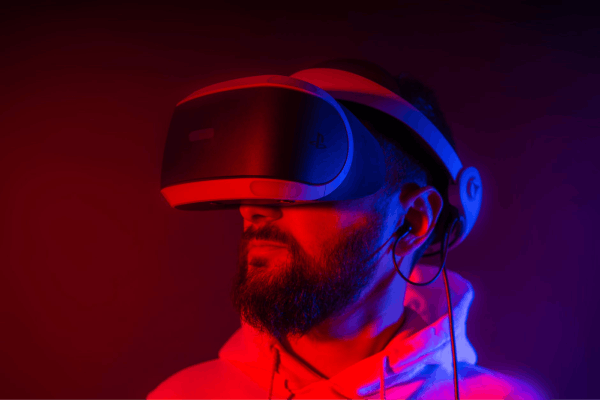
How to apply this training theory:
Video learning is perhaps the most powerful way to stimulate the multi-senses of your learners. Involving moving images and sound, sometimes even text, learners will be compelled to use the combination of different senses to fully understand the content presented to them.
You can also take advantage of virtual reality (VR) training, where your employees will learn specific skills or methods through virtual presentation and exercises. Here, they will also be able to utilize their senses when participating in their own virtual training world. In case you don’t have enough expertise to develop a VR training program, you can get some help from Elearning Brothers. This software offers an advanced authoring tool that supports the VR format. Just transform your slides to 360-degree photographs or videos, add hotspots, hit publish and go.
9. Storytelling learning theory
In this training theory, storytelling is regarded as one of the most effective ways to transfer knowledge to your team. According to studies, it was found that transforming information into a well-told story and more relatable scenario results in higher learning retention. By putting meaning into your information and data points, they are far easier to grasp and understand than presenting them in long training modules, graphs, or tables.

How to apply this training theory:
When presenting a set of new knowledge, consider backing them up with anecdotal evidence or case studies that are relatable to learners. You can also get your creative juices flowing by creating a whole new story that is parallel to the current tasks of your employees. Use relatable characters and build probable scenarios with conflicts to better illustrate the concepts and processes.
Another way to incorporate this training theory into your training program by initiating a sharing session with your team. Allow them to share their own stories, struggles, and experiences relevant to the purpose of your training.
10. Social learning theory
Social learning theory is grounded in the key assumption that people gain new knowledge by observing and imitating the actions of their peers, instructors, and mentors. Basically, this situated learning states that learning can also occur even by simply observing others, even with the absence of experience. For example, you will probably know how to shoot a ball in a ring even if you have never tried it in your life. This is due to the fact that you have already seen how it’s done, either in person or on television.
This observational learning expands on the behavior learning theory. It also assumes that reinforcement and response greatly influence whether a behavior is acquired or not.

How to apply this training theory:
The best way to apply this training theory in the workplace is by having a new hire or an underperforming employee follow their peers on how to perform a task or solve a particular problem-based learning. You can also use the video learning technique to present a string of procedures and allow your learners to incorporate the same techniques into their own individual task.
Join our blog newsletter
Author
Jeanellie Avelino
Jen is a learning expert at EdApp, a mobile-based training platform that helps corporates and businesses bring their training solutions to the next level. She carries an extensive writing experience in a variety of fields, including architecture, the gig economy, and computer software. Outside of work, she enjoys her free time watching her favorite series and documentaries, reading motivational books, and cross-stitching.
